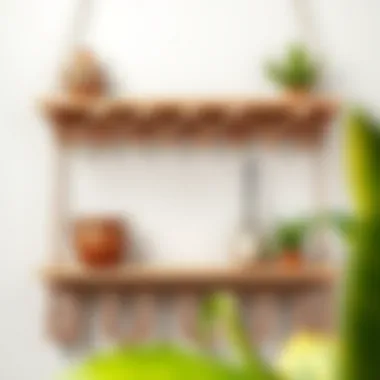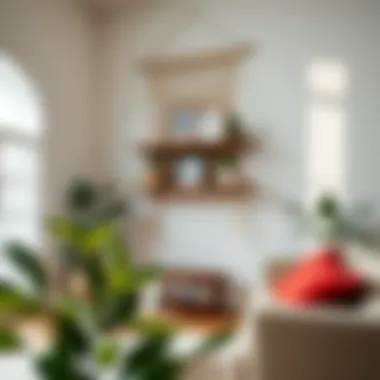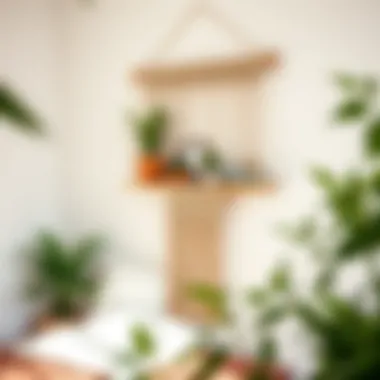Crafting Macrame Wall Hanging Shelves for Modern Décor


Intro
Macrame wall hanging shelves have become a stunning addition to the décor scene, offering visual interest and functional solutions for various spaces. They are not just about holding knick-knacks; they tell stories of craftsmanship, creativity, and evolution over time. In today’s fast-paced world, where a backdrop of minimalism sometimes reigns, these intricate pieces show a return to handcrafted artistry. But why are macrame shelves gaining popularity, and what makes them such compelling objects in homes and commercial settings alike?
As we dive deeper into the domain of macrame, we uncover layers of history, techniques, and aesthetics that shape these creations. A well-crafted shelf can effortlessly bring charm to your interior while serving a purpose. From the meticulous knotting methods to the materials chosen for sustainability, the paths leading to a beautifully handwoven shelf are varied and rich.
Let's explore the contemporary landscape of these creations, how they merge function with artistry, and tips for choosing or crafting your very own piece. This journey is not just for design enthusiasts; it’s an invitation for anyone looking to enhance their spaces in an eco-friendly and artistically fulfilling manner.
Preface to Macrame Wall Hanging Shelves
In the world of home décor, macrame wall hanging shelves stand out as a fascinating blend of artistry and functionality. These pieces are not just about holding your favorite knick-knacks; they serve as a testament to craftsmanship that has been handed down through generations. The importance of examining macrame shelves lies in understanding their dual role: enhancing the aesthetic vibe of a space while offering practical storage solutions. Today, many seek sustainable, stylish alternatives to conventional shelving, making macrame particularly relevant.
Macrame is more than simply tying knots; it embodies a creative expression that speaks to many. The intricate designs and intricate patterns showcase a unique way to display one’s personality and style. As a method that intertwines artistry with utility, these wall hanging shelves can transform any room, lending character and warmth. Bringing one of these structures into your home could easily be seen as adding a personal touch that resonates in the atmosphere.
Defining Macrame and Its Significance
Macrame refers to the art of knotting cord or string into decorative patterns. Originating from various cultures worldwide, this craft has gained a cult following among those who appreciate handmade artistry. The significance of macrame lies in its versatility and ability to adapt to various design contexts. From minimalist to bohemian, it has found its niche across diverse interior styles.
The technique itself has a rich history intertwined with maritime culture. Sailors from centuries ago would use knots for practical purposes, but over time, it blossomed into an art form. Macrame brings a tactile quality that synthetic materials often lack; its handmade nature speaks volumes in a society that increasingly values authenticity.
The Emergence of Wall Hanging Shelves
The rise of wall hanging shelves crafted from macrame is both an artistic and functional evolution. These shelves began surfacing in the 1970s, during the craft revival movement, before fading in and out of popularity. However, in today’s market, we’re witnessing a surge—thanks largely to the DIY culture and sustainable living trends. Boutique owners and design enthusiasts are keen on incorporating macrame pieces, igniting an interest that stretches far beyond mere decoration.
This resurgence can largely be attributed to the growing desire for home personalization. Shelves can replace conventional storage options and can be styled to reflect individual tastes. A well-placed macrame shelf can become a focal point, drawing the eye and sparking conversations. What makes these shelves particularly intriguing is not just their eye-catching aesthetic; they represent a fusion of art and function that matches the evolving needs of modern homes.
In essence, macrame wall hanging shelves signify a movement towards more thoughtful, creative living spaces. As we proceed, we'll explore the historical context of macrame, the materials and tools required, and the crafting techniques that breathe life into these unique creations.
Historical Context of Macrame
Understanding the historical context of macrame enriches one's appreciation of its intricate designs and functionality. Macrame, its roots firmly planted in artisan tradition, not only showcases creativity but also tells a story of its enduring relevance in art and interior design. This section will explore how macrame evolved from practical seafaring knots to contemporary décor elements adorning homes globally. This journey through time reveals significant milestones that shaped macrame’s identity and highlights its journey through various cultures and eras, providing clarity on why this craft has captured hearts today.
Origins in Maritime Culture
Macrame's beginnings can be traced back to the 13th century, primarily among Arab weavers. The term itself likely comes from the Arabic word "migramah," which refers to the fringes of a woven fabric. Sailors adopted this technique during long sea voyages to create decorative knots for securing objects and dunning ropes. The practicality of macrame stems from its utility in a volatile maritime environment. Those early craftsmen relied on knots not only to secure their sails but also to express their artistic inclinations.
As maritime trade flourished, the art spread through Europe, notably in Spain and Italy, where it became synonymous with home decoration. Sailors would often bring back macrame artifacts, transforming the craft from simple utility to an admired pastime among the elite.
Evolution Over Time
The evolution of macrame reflects broader cultural shifts. By the 17th century, macrame became popular in homes across Europe as a fashionable decorative art form. No longer merely a tool for sailors, macrame adorned curtains, tablecloths, and trimmings for clothing. Its adaptability made it appealing across various social classes.
Key Milestones:
- 19th Century: Macrame gained traction during the Victorian era, with the rise of needlework societies. Women began using macrame in lace-making, and this intricate knotting became a household pastime.
- 20th Century: The craft saw a resurgence in the 1970s during the bohemian lifestyle movement. Young artisans embraced macrame, using it to create plant hangers and wall art, effectively reintroducing the technique to modern culture.
- Recent Years: In our digital age, macrame is experiencing a renaissance. Handcrafted pieces are celebrated for their uniqueness and the personal touch they bring to home décor. The practice not only serves aesthetic purposes but also underscores a broader movement towards sustainability and handmade goods.
Macrame has journeyed from essential knots to cherished home décor, adapting to the needs and tastes of each generation. Its historical relevance is a testament to craftsmanship's enduring connection to cultural aesthetics and functional design.
Materials and Tools Required
The art of creating macrame wall hanging shelves begins with a solid understanding of the materials and tools that are essential for crafting. The right selections not only enhance your artistic experience but also ensure the durability and aesthetic quality of your finished product. In a craft that balances function with creativity, every detail—right from the cord to the knot techniques—plays a pivotal role.
Choosing the Right Cord
Types of Macrame Cord
When it comes to macrame, the type of cord you choose isn’t just about aesthetics; it’s fundamental to the structural integrity of your shelf. Cords come in various materials, such as cotton, jute, and nylon, each presenting a unique set of qualities. For example, cotton cord is favored for its softness and ease of knotting; it creates a warm, inviting look ideal for rustic or bohemian interiors. In contrast, jute cord offers a more textured appearance, evoking a natural feel that’s particularly appealing in eco-conscious design spaces.


The key characteristic to consider is strength. High-tensile cords can support heavier loads, making them more suitable for shelves that will bear decor items like books or plants. A downside to thicker cords, however, is that they may complicate intricate knotting patterns. In summary, the choice of cord not only affects the visual aspect but also the functionality of your macrame shelf design.
Natural vs Synthetic Options
The debate between natural and synthetic options comes down to the balance between environmental consciousness and practicality. Natural fibers like cotton and hemp align closely with sustainable practices—they’re biodegradable and contribute positively to the ecological footprint of crafting. Plus, you get the benefit of a soft texture that feels great to work with.
On the other hand, synthetic materials like nylon can boast greater durability and weather resistance, particularly if your shelf is going to hang outdoors or in humid areas. They are less likely to fray and can hold up well against fading. Nevertheless, the unique feature of natural cords is their ability to hold knots firmly without slipping, making them a popular choice for intricate macrame designs. Resistance to wear and tear might come with synthetic cords, but nothing trumps the charm and warmth of natural fibers in a home setting.
Essential Tools for Crafting
The tools you utilize can make or break the effort you put into your macrame wall hanging shelf. Having the right tools on hand is crucial for transforming materials into tangible art.
Knots and Techniques
Understanding an array of knots is what sets apart a professional creation from a novice attempt. The basic knots, like the lark’s head or square knot, serve as your building blocks for more complex designs. These fundamental techniques not only contribute to aesthetics but also enhance the structural integrity of your piece. Take the double half hitch, for instance—it allows you to create beautiful diagonal patterns that can elevate your shelf's overall look.
The key characteristic here is versatility. A solid grasp on various knotting techniques provides you with the freedom to experiment and innovate. While skill development may take time, the payoff is significant, paving the way for unique creations that showcase your personal style. Some knots may slip or come undone if not executed properly, so it's crucial to practice and hone your skills.
Measuring and Cutting Tools
Good craftsmanship doesn't just happen; it requires precision as well. Measuring tools, such as tape measures or yardsticks, are essential for ensuring that your cord lengths are accurate, which in turn, affects the balance and symmetry of your shelf.
A unique feature of using the right cutting tools is the clean edge they leave, which reduces fraying. Employing sharp scissors or wire cutters can prevent the annoyance of unraveling fibers that can compromise the integrity of your projects.
The key characteristic of these tools is efficiency. They help streamline your efforts, allowing you to focus more on the creative aspect instead of struggling with inaccurate measurements or ragged edges. High-quality measuring and cutting tools might represent a slightly higher initial investment, but they enable a more enjoyable crafting experience with better results.
Crafting Techniques for Macrame Shelves
Crafting techniques play a pivotal role in the creation of macrame wall hanging shelves. The journey of turning simple cords into intricate designs requires not only tools and materials but also the right techniques. Knowing how to manipulate these cords opens a world of possibilities, enabling crafters to design decorative yet functional pieces that can enhance any space. With a growing trend towards handmade goods, mastering these techniques is not just about skill, it's about embracing tradition, creativity, and a touch of personal flair. This section dives into the basic knots and the structures that make macrame shelves not only visually appealing but also structurally sound.
Basic Knots and Their Applications
Lark’s Head Knot
The Lark’s Head Knot is where it all starts. This knot forms the foundation in macrame projects because it’s unbelievably straightforward yet incredibly effective. When attaching cords to a rod or surface, this knot shines; it holds tight without slipping, making it a favorite among both beginners and seasoned crafters. One of its key characteristics is its symmetric design, which adds a polished look to your project.
The beauty of the Lark’s Head Knot lies in its simplicity and versatility. This knot can be used in various patterns, allowing the designer flexibility in their work. However, it’s not without fault. If applied too loosely, it can be a weak point in the structure. This means attention to detail is paramount when using it.
Square Knot
Just as crucial within the macrame lexicon, the Square Knot combines two lark’s head knots into one cohesive unit. This knot is ideal for creating connecting lines or added texture in a design. The striking visual of interlocked cords can draw the eye while providing solid construction. A characteristic feature of the Square Knot is its ability to lie flat, which enhances the overall appearance of a shelf.
By intertwining cords in this manner, it offers strength and stability, especially where weight may be a concern. Although it’s one of the more traditional knots, its effectiveness cannot be overstated. The downside? This knot does require a bit of practice to master, which might deter some novice crafters.
Double Half Hitch
For more intricate designs, the Double Half Hitch knot brings a unique flair. It allows for a more complex and flowing design, serving both functionality and style. The Double Half Hitch is characterized by its ability to create patterns along vertical or horizontal axes. When you see a macrame shelf with beautifully defined lines, odds are, this knot was used in its construction.
This knot is beneficial not just for its aesthetic appeal but also for its robust nature. It's particularly useful for creating cascading effects on your shelves. However, if not executed correctly, it may lead to uneven tension in your design, which can compromise the entire structure.
Designing a Macrame Shelf Structure
Designing a macrame shelf structure takes creativity and careful planning. The structure needs to combine form with function, which can be an exciting challenge for the enthusiast as well as the novice.
Simple Shelf Designs
When starting out, simple shelf designs are the way to go. These designs often employ basic knots and straightforward patterns, making them accessible for those still honing their skills. The key characteristic of a simple design is that it focuses on minimalism and functionality. This choice is particularly beneficial for individuals looking for a quick project or those who prefer a clean aesthetic.
Unique features of simple designs often include straight lines and efficient use of space. They tend to require fewer materials and less time, which is great for anyone short on both. The downside is that they may lack the intricate beauty that more complex designs boast, but sometimes, less is more.


Complex Patterns and Variations
On the flip side, complex patterns and variations invite more advanced techniques into the mix. Crafting these shelves allows for artistic expression, as crafters can incorporate mixed knots and intricate details. The dynamic aspect of complex designs can captivate and evoke a sense of wonder in any onlooker.
This style encompasses more extensive use of different knots and creative spacing, making each piece truly unique. However, the challenge here is substantial; it demands a higher skill level and patience. If someone wishes to create a showstopper, the complexities will pay off, but it requires more time and dedication than the simpler designs.
In essence, crafting techniques for macrame shelves set the stage for creativity and usage of form. The choice of knots and designs has a lasting impact on the overall aesthetic and sturdiness of the final product. Understanding these basics is essential for embarking on your own macrame journey.
Incorporating Macrame Shelves in Home écor
Incorporating macrame shelves into home décor is no small feat; it is an exercise in blending aesthetics with functionality. These handcrafted beauties add a unique touch to any room, presenting both a visual feast and practical storage solutions. The organic knots and natural materials create a feeling of warmth and creativity, instilling an inviting ambiance. One of the most compelling reasons to integrate these pieces into your living space is their versatility. Whether you're decorating a cozy nook or making a statement in a wide open living room, macrame shelves can elegantly adapt to various themes and styles.
Versatility in Different Rooms
Living Room Applications
In the living room, macrame shelves serve as more than mere storage; they double as a focal point that captivates attention. What sets them apart is their ability to blend seamlessly with both modern and vintage styles. Hanging a macrame shelf adorned with plants or decorative objects can invigorate an otherwise dull wall. These shelves draw the eye upward, creating an illusion of space and even height, which is particularly advantageous for smaller rooms. However, one must consider how the shelf’s design complements the existing furniture and color schemes; missteps here can lead to a visual clash that distracts rather than delights.
Kitchen and Dining Areas
The charm of macrame shelves doesn't stop at the living room; they offer delightful solutions in the kitchen and dining areas as well. A floating macrame shelf can provide a stylish platform for spice jars, cookbooks, or even decorative dishware. This functionality adds not just storage but also personality to your culinary hub, turning a practical area into a gallery-like setting. However, careful thought must be given to the materials and placement; for example, proximity to heat sources or moisture can compromise integrity over time.
Bedroom Uses
In the sanctuary of rest and relaxation, namely the bedroom, macrame shelves play a unique role. They offer a canvas for personal treasures and an opportunity to showcase curated collections that resonate with the inhabitant's personality. From books to succulents, the choices for display are vast. The intricate designs often evoke a sense of calm, perfectly complementing the ambiance of a peaceful retreat. However, it’s essential to keep the arrangement balanced; overcrowding these shelves can negate their calming effect, so keep aesthetics in mind when selecting items.
Pairing with Other Interior Design Elements
Complementing Natural Materials
Macrame’s natural aesthetic pairs beautifully with organic materials such as wood, stone, and metal. This harmony creates a visually pleasing environment where textures intermingle fluidly. The key here is to select materials that beguile the eye, such as reclaimed wood for the shelf itself or stone plates for display. This approach not only elevates the overall design but also speaks to a broader trend of using sustainable resources. Just be cautious; excessive mismatched textures can muddle the overall design intention.
Color Coordination Techniques
Color coordination techniques are pivotal in enhancing the overall appeal of macrame shelves within your home. A well-chosen color palette can make or break the visual coherence of your space. You might aim for a neutral background to let the intricate knots and patterns of the macrame pop, or perhaps you want to match the shelf with vibrant hues found elsewhere in the room. The essence of combining colors lies in creating a harmonious blend that doesn’t overwhelm the senses. A thoughtful approach can turn the macrame shelves into visual anchors that draw the eye in a subtle yet powerful manner.
"Integrating macrame shelves into your home is not merely about style; it involves creating a living space that tells a story."
Sustainability and Eco-Friendly Practices
In today's world, where environmental consciousness is crucial, the relevance of sustainability in our everyday craftsmanship cannot be overstated. Macrame wall hanging shelves, with their blend of practicality and creativity, present a unique opportunity to embrace eco-friendly practices. As people grow more aware of their ecological footprint, artists and crafters are increasingly seeking out sustainable methods and materials. This section aims to explore the importance of sustainability in the macrame scene, highlighting the advantages it brings not just to the artisans but to the environment as well.
Sourcing Sustainable Materials
When creating macrame shelves, the choice of materials plays a pivotal role. Opting for sustainable materials can not only enhance the aesthetics of the finished product but also lessen its environmental impact. There are several strategies to source eco-friendly materials for your macrame projects:
- Organic Cotton Rope: Grown without harmful pesticides or fertilizers, organic cotton is a popular choice among crafters committed to sustainability. Its softness and durability make it perfect for both beginners and seasoned artisans alike.
- Bamboo Cord: Another strong contender is bamboo cord. Renowned for its quick growth and minimal resource requirements, bamboo is a renewable resource that can add a unique texture to your creations.
- Recycled or Upcycled Materials: Many artisans are turning to recycled fibers, such as cotton blend or repurposed t-shirts, to craft their designs. Using these materials not only reduces waste but also gives new life to items otherwise destined for landfills.
Choosing these materials not only supports sustainable production methods but also often embodies stories, adding layers of meaning to your macrame pieces. The words "reduce, reuse, recycle" take on a genuine context here.
Impact of Macrame on Environmental Awareness
The resurgence of macrame can be seen as a reflection of a broader shift towards conscious consumerism. Artisans who partake in this ancient craft are often educating others about the significance of sustainable practices, thereby fostering a community of like-minded individuals. The impact of macrame on environmental awareness isn't just about the physical products created; it’s also about the conversations sparked around sustainability.
For example, when a macrame artist chooses to go green in their materials, they might share that journey on social media platforms or local workshops. This exchange not only raises awareness but can encourage others to rethink their choices in crafting and consumption.
"Crafting is not just about creating beautiful pieces; it's about nourishing our connection to the earth and our community."
The collective movements driven by the macrame community are crucial in tackling broader environmental issues. As more artisans commit to sustainable practices, they pave the way for future generations to value eco-friendly craftsmanship.


Macrame in Contemporary Design Trends
The resurgence of macrame in today's interior design landscape cannot be overstated. Once considered a relic of the past, macrame has bounced back, weaving its way into modern aesthetics with flair and functionality. Now, it serves not only as a means to create beautiful décor but also as a statement on the value of handcrafted artistry in an age dominated by mass production. This section sheds light on the vibrant trends that have spun from the fibers of macrame, providing insight into both the appeal and advantages of incorporating this craft into contemporary homes.
Revival of Handcrafted Art
The rebirth of interest in handcrafted art, including macrame, signals a shift in consumer preferences. In a world where everything seems to come off an assembly line, people are gravitating towards unique, handmade pieces. This newfound appreciation is not merely about personal taste; it taps into a larger narrative about authenticity and craftsmanship.
Macrame reflects this narrative beautifully. Each knot tied in a piece tells its own story, adding character that factory-made items simply lack. It’s like wearing a pair of hand-stitched shoes versus a store-bought pair; one is a work of art, and the other is just a cover for your feet.
Moreover, as individuals seek out personal connections in their living spaces, macrame provides that element of intimacy. It allows for customization, enabling the maker to blend their creativity with the desires of the consumer. This interaction elevates macrame from mere décor to meaningful art.
Innovations in Macrame Techniques
Modern artisans are not just reproducing traditional macrame techniques; they are pushing boundaries, integrating fresh ideas and materials into their work. This innovation is pivotal for setting macrame apart from its historical essence, allowing it to thrive in today's design scene.
Some prominent avenues of innovation include:
- Mixing Textures: Artisans are blending different types of cords, such as natural fibers with textiles or plastic materials, offering a unique touch in both feel and appearance.
- Hybrid Designs: Macrame is being combined with other art forms, like wood and ceramics. Shelves featuring macrame elements paired with wooden mounts become not just functional but also sculptural pieces.
- Sustainable Practices: With a growing emphasis on eco-friendliness, many creators are now sourcing organic materials and dyes, aligning macrame with contemporary environmental values.
"The hands that craft macrame pieces today are not just holders of tradition; they are molders of innovation."
The fresh perspectives, tools, and materials available today allow for a broad spectrum of creativity. This evolution captures the hearts of fashion enthusiasts and boutique owners, making macrame a staple in stores and homes alike. From luxurious, intricate wall hangings to sleek shelf designs, this trend emphasizes that macrame isn't just an art form; it’s an experience that connects us to craftsmanship in its most beautiful form.
Utilizing these innovative techniques ensures that macrame remains at the forefront of home décor trends, ultimately proving that while styles may evolve, the essence of artistry remains timeless.
To explore more about the evolution of macrame, check out articles from Wikipedia, and for community discussions on contemporary practices, websites like Reddit can provide valuable insights.
Showcasing Your Macrame Wall Hanging Shelf
Showcasing your macrame wall hanging shelf serves more than just a decorative purpose; it's an expression of personal style, creativity, and functionality. In an age when minimalism often dominates, these intricate, handcrafted pieces can be a delightful counterpoint, infusing spaces with warmth and character. Each shelf not only displays items but also tells a story, weaving together the threads of art and everyday life. Thus, understanding this aspect is essential for anyone looking to enhance their space with unique décor.
Displaying Decorative Items
When it comes to displaying decorative items, a macrame wall hanging shelf offers a perfect stage. The open, airy design draws attention to the objects placed upon it—be it a lush succulent, a vintage trinket, or a compelling piece of artwork. Here are some tips for showcasing these items effectively:
- Height Variation: Position items of differing heights to create a visually engaging display. Taller plants can sit at the back, while smaller ornaments can be more forward, allowing each piece to shine without overshadowing one another.
- Color Coordination: Sticking to a palette that complements both the shelf and the room can enhance harmony. For example, if your shelf is a natural cotton color, vibrant succulents in earthy pots can create a lively contrast.
- Personal Touches: Items that hold personal significance—photographs, souvenirs from travels, or handmade crafts—can transform the shelf from a mere display into a showcase of memories and milestones.
By judiciously choosing what to display, one can create a dynamic arrangement that reflects individual tastes while emphasizing the beauty of the macrame craftsmanship.
"Your wall hanging shelf is more than just a piece of furniture; it’s a canvas for your creativity. Make it yours."
Functional Uses in Everyday Life
Macrame wall hanging shelves are not just visually appealing; they also come with practical applications that can enhance day-to-day living. Here are several functional uses to consider when integrating these shelves into your home:
- Storage Solutions: Use the shelf for practical storage of books, magazines, or small baskets that can hold miscellaneous items, keeping your space organized without sacrificing style.
- Plant Displays: Ideal for plant lovers, these shelves provide a unique way to showcase greenery. Climbing plants can be particularly eye-catching, as their tendrils drape elegantly from the shelf.
- Kitchen and Bathroom Utility: In the kitchen, use it to display spices in attractive jars or to keep everyday essentials within reach. In bathrooms, it can hold toiletries or decorative candles, merging function with aesthetics.
Incorporating macrame shelves into daily life not only beautifies your environment but also offers simple and effective ways to simplify organization. This blend of art and utility is what truly makes macrame wall hanging shelves a noteworthy addition to any home.
Ending
The Lasting Appeal of Macrame Wall Hanging Shelves
Macrame wall hanging shelves have a unique timelessness that marries artistic expression with practical utility. They are not just decorative accessories but serve as functional pieces that elevate the aesthetic value of a space. With the intricate knots and patterns, each shelf becomes a canvas that showcases craftsmanship. These shelves are often made from sustainable materials, emphasizing both environmental consciousness and design elegance. The ability to customize every strand allows for personalization that resonates with individual styles.
The increasing popularity of macrame in interior design isn’t just a fleeting trend. It speaks to a deeper appreciation for handmade artistry in a world that’s often dominated by mass production. Homeowners and decorators alike find joy in the tactile feel of natural fibers and the visually captivating textures they create. Furthermore, the versatility of macrame means that these shelves can adapt fluidly to various design aesthetics, whether bohemian, rustic, or modern. This adaptability enhances their desirability and ensures a lasting presence in homes.
Invitation to Create
Creating macrame wall hanging shelves invites everyone to embrace a hands-on approach to design. It encourages not just the crafting of objects, but the formation of personal stories and spaces infused with individual character. When individuals take on the task of making their own macrame creations, they embark on a journey that connects them to the traditions behind this ancient craft, all while carving out their unique artistic identity.
For those aspiring to explore this craft, starting can be as straightforward as gathering a few essential materials—some cord, basic tools, and a bit of patience. Online forums, local workshops, and resources can be great starting points, fostering community engagement and support. By welcoming this creation process, one steps away from passively consuming decor to actively participating in building their aesthetic world.
In a time where the notion of individuality is paramount, macrame wall hanging shelves serve as more than mere decor; they represent a bridge between tradition and modernity, allowing everyone to root a piece of their personality within their space. So, pick up that cord and let creativity take the reins!







